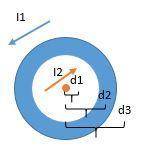
Physics, 16.11.2019 05:31 janetexcoelho
Along, hollow, cylindrical conductor (inner radius 3.4 mm, outer radius 7.3 mm) carries a current of 36 a distributed uniformly across its cross section. a long thin wire that is coaxial with the cylinder carries a current of 52 a in the opposite direction. what is the magnitude of the magnetic field (a) 1.1 mm, (b) 3.6 mm, and (c) 7.4 mm from the central axis of the wire and cylinder?

Answers: 3


Other questions on the subject: Physics

Physics, 21.06.2019 21:50, yairreyes01
Adiver in midair has an angular velocity of 6.0 rad/s and a moment of inertia of 1.2 kg·m2. he then pulls is arms and legs into a tuck position and his angular velocity increases to 12 rad/s. the net external torque acting on the diver is zero. what is his moment of inertia in the tuck position?
Answers: 1

Physics, 21.06.2019 22:30, celibe9391
What is the earliest point in the universe that we can observe? why can’t we see back further than this?
Answers: 2

Physics, 22.06.2019 13:40, andrespiperderc
Use the profile illustrated for problem (1). assume that the layer of silty sand fill (sm) is placed over the entire site. estimate the thickness of the fill (h - in feet) that will cause the effective vertical stress at the center of the clay layer to increase by 517.5 pounds per square foot.
Answers: 1

Physics, 22.06.2019 19:40, flore9584
Which of the following is a characteristic shared by both electron and light microscopes? a. they both employ the use of objective lenses. b. both microscopes require an internal camera to visualize the specimen. c. both microscopes have a resolving power of 0.01 nm. d. they both utilize white light to magnify the specimen.
Answers: 2
You know the right answer?
Along, hollow, cylindrical conductor (inner radius 3.4 mm, outer radius 7.3 mm) carries a current of...
Questions in other subjects:

Mathematics, 16.07.2019 22:40




Biology, 16.07.2019 22:40



Biology, 16.07.2019 22:50














